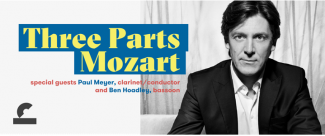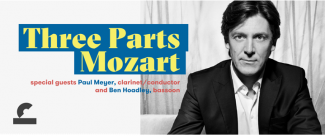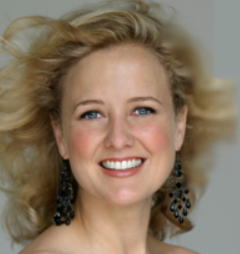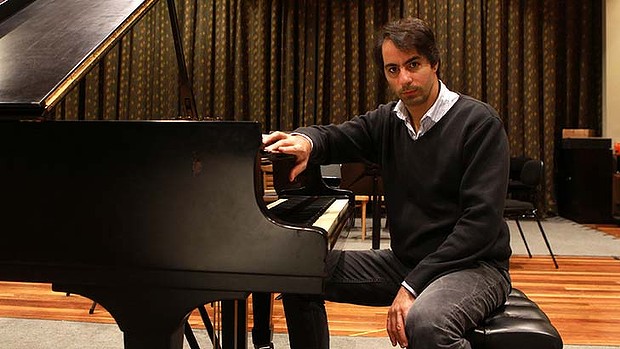Concert Review: Three Parts Mozart/ Omega Ensemble With Paul Meyer

Three Parts Mozart
Omega Ensemble, Paul Meyer, clarinet
City Recital Hall
November 3, 2016
Written By Deen Hamaker
The music of Wolfgang Amadeus Mozart is such a fundamental part of the classical repertoire it is easy to forget that he died when he was just 35. He was an incredibly prolific, composing over 600 pieces in his short life. For their last concert of their season, Omega Ensemble was augmented for the first time, to Chamber Orchestra format with 23 players. They performed three different pieces from Mozart’s later career alongside a symphony from Joseph Haydn.
The concert opened with Haydn’s Symphony in D major, No. 6 ‘Le Matin’, named for its famous opening evocation of a sunrise. The ensemble played with verve. Written in the first few months of Haydn’s employment to the Esterházy court in 1761, the piece features several solo parts for different instruments in the ensemble, all of which were executed brilliantly. It was clear from the beginning that the players were enjoying working with Paul Meyer. This was especially evident in the next piece by Mozart as Meyer moved from conductor to clarinettist.
Paul Meyer played Mozart’s Clarinet Concerto from 1791 with great dexterity and clarity. Composed at the very end of Mozart’s life, this concerto is the last instrumental piece that Mozart completed. It is one of Mozart’s most famous concertos. Composed for clarinet virtuoso, Anton Stadler it features frequent florid passages. The ensemble played brightly, yet blending beautifully with the solo clarinet of Paul Meyer, who executed the famous runs with elegance, refinement and an infectious enthusiasm shared by the other players.
From one of Mozart’s final pieces we went back in time to one from his late teens, written when he was 18 years old, his Bassoon Concerto in B flat major. By this time, the precocious Mozart had already written 25 symphonies. However, it was his first concerto for a wind instrument. With a youthful abandon, Mozart pushed the possibilities of the bassoon, particularly in the first movement. The solo line brings out the instrument’s comedic colours, with unexpected leaps into the upper reaches of its range and plunges into its depths. Bassoon soloist Ben Hoadley played wonderfully, bringing the dark but slightly jovial character of the instrument to the fore.
For the final piece on the programme the ensemble played one of Mozart’s most famous pieces, the Symphony No.40 in G Major. When playing a piece so well-known there is no room to hide and on this occasion, the playing was universally excellent. While the ensemble may have taken a little while to warm up in the previous pieces on the programme, in this finale they were firing on all cylinders from the outset, playing with exceptional concentration and precision. The mood of this symphony is unusual for the period as it doesn’t begin brightly and lightly, instead, starting with an intensity of passion and feeling, similar to the music of Mozart’s opera, Don Giovanni, which he completed the year before.
Throughout the concert the ensemble played with sparkle and vigour. Particular kudos goes to flautist Eric Lamb, who exemplified the enthusiasm of the entire ensemble. His joy and animation were a pleasure to watch. The playing throughout the concert was excellent and maintains the high standards of the Omega Ensemble. One critique that I would make is that while the glories of Mozart when played at this level are always a joy, some variation in the programme, such as a 20th century piece would have increased the opportunity for the audience to reflect of Mozart’s musical legacy.
With a newly released CD on the ABC Classics label and a bright and varied 2017 season recently announced, the Omega Ensemble has a promising future in store.
Deen Hamaker for SoundsLikeSydney©
Deen Hamaker is a passionate opera aficionado and commentator. Introduced to theatre, opera and classical music at a very young age, he has acted in and directed several theatre productions, both in Australia and overseas. Deen lived in Japan for several years and studied the performing arts of Asia. Deen’s particular passion is opera, particularly the Russian, French and Modern repertoire. Deen was a contributing author for “Great, Grand and Famous Opera Houses”, 2012. Fluent in Japanese, Deen holds a Bachelor of Arts in Japanese from Griffith University and currently lives in Sydney.







